

The Sobieski-Stuart Dynasty
CONTROVERSY:
This is the geneaological chart of the controversial Sobieski-Stuart Dynasty. Many have claimed descent from this line, and most did so without proofs that have satisfied modern genealogists. In Clive Cheesman's book Rebels, Pretenders, and Imposters he shows us that this is common, not just in the Sobieski-Stuart line, but in many other royal lines.
It must be noted that even if these claims are true that they would offer little concilation since there is no chance that these people would ever be considered as monarchs. These claims won't offer much more than bragging rights.
I have used readily available sources (in English) to assist anyone who thinks they might have this family connection. This chart is in no way complete, and is set here as a guideline or jumping off place. As all good genealogists must do, you must confirm your own charts through hard records such as birth certificates, death certificates, land records, marriage records, etc. I have noted those lines that are considered "bogus" in green. I have placed Stuart lines in "red," and French lines in "blue."
STEWART VERSUS STUART:
Be reminded that the change in spelling from Stewart to Stuart is caused by the fact that in French there is no "W." Therefore, after the "Stewarts" were exiled to France, they became known as "Stuart."
Written and researched by Margaret Odrowaz-Sypniewska
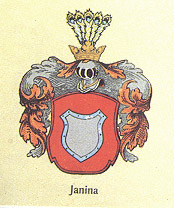
THE NAME SOBIESKI:
The name Sobieski is of Polish Origin. It means one who came from Sobieski, Sobieszki, or Sobieszyn (Sobiech's settlement), the names of various villages in Poland (Smith, Eldson C. New Dictionary of American Names. New York: Gramercy Publishing Company, 1988). William F. Hoffman's book Polish Surnames: Origins and Meaning says that the root of this name ("Sob") means "self."
GENERATION ONE:
James V (1512-1542) married (1) Madaline of France (2) In 1538, James married Mary de Guise and Lorraine. Mary's children were: James, Arthur, and Mary (b. 1542).
GENERATION TWO: Mary, Queen of Scots married (1) Francis, the Dauphin, later Francis II of France, son of Henri II. (2) Henry Steward Darnley (1545-1567), Duke of Albany. Henry was the son of Matthew, Earl of Lennox. (3) James Hepburn, Earl of Bothwell, Duke of Orkney.
Marek Sobieski (1549-1605) was the son of Jan Sobieski (1518-1564) and Katarzyna Gdeszynska (1531-1600). Marek married Jadwiga Snopkowski (1556-1588), daughter of Jakub Snopkowski (1530-1578) and Anna Herburtowna (1535-?)
GENERATION THREE: James VI (1566-1625), crowned King of the Scots, in 1567. James was later made James I, King of England. James married Anne of Denmark, daughter of Frederick II, King of Denmark. Their children were Henry, Charles, Robert, a unnamed son, Elizabeth, Margaret, Mary, and Sophia.
Jakub (James) Sobieski (1580-1646), was Wojewoda of Ruthenia and Castellan of Cracow. In 1665 he married Zofia (Theophila) Danillowiezovna (1607-1661). Zofia's brother, Stanislaw Danillowicz, died in Tartar captivity. Zofia was the daughter of Jan Danilowicz (1570-1628) and Zofia Zolkiewska (1590-1634). Zofia's grandparents were: Stanislaw Zolkiewski (1550-1620) and Regina Herburtowna (1566-1626).
GENERATION FOUR
Charles I (1600-1649) become the King of England in 1625. He married Henrietta Marie (1609-1669), daughter of Henry IV of France.
Elizabeth (1596-1662) married Frederick, King of Bohemia (1596-1632).
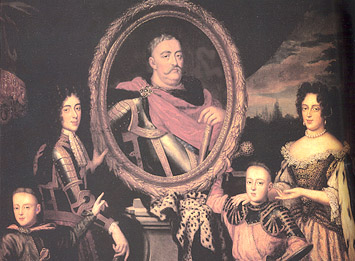
This print is of the oil painting by Henri Gascar
(1634/5-1701), a French painter, and is
presently housed at Wawel Castle in Cracow
***in this version two children are missing.
Marek Sobieski died in 1652.
King Jan III Sobieski, King of Poland (1629-1696) was born at Olesko, near Lwow, as the second son of Jakub and Maria Sobieski.
He received his Latin education at Nowodworski Gymnazium in Cracow, and at the Jagiellonian University, and in 1646-1648 he departed on a Grand Tour, which took him to Paris, London, and Amsterdam. In 1652, his eldest brother died and he inherited land and money from the Sobieski, the Zolkiewski, and Danillowicz lines. Jan's grandfather was Hetman Zolkiewski, and he and his brother were both beheaded in battle with the Tartars; while his uncle, Stanislaw Danillowicz died in Tartar captivity. Jan was the hetman of the Crown from 1668 and King from 1672. He was said to have been a popular monarch. He chose a military career and joined the army in 1648, and fought with Chmielnicki's Rebellion and the Swedish "Deluge" under Jerzy Lubomirski and Stefan Czarniecki.
Jan began his military career, at age 20, in 1649. Sobieski was a Colonel from August 1655 through March 1656 under Charles X. He joined the embassy to Constantinople in 1654. He was presented at court in 1655, envoy to the Seym in 1659, Grand Marshal in 1665, and Field Hetman in 1666. He then was given the baton of the Grand Hetman of the Crown in 1668. He fought in numerous battles against Turkey, and during the siege of Vienna in 1683. He was called "the Lion of Lekhistan," conqueror of the Turks. In 1672 Jan Sobieski was the head of the French backed Confederation of Szczebreszyn. In older age Jan suffered from gallstones, which kept him from later battles.
Jan married Marie Casimire Louise de la Grange (1641-1716), Princess d'Arquien, daughter of Henri de la Grange, Marquis Cardinal d'Arquien. In Poland, she was known as "Marysienka." She came to Poland, at age four, with the French Queen, Marie-Louise. She was the daughter of the Captain in the French Guard, and the Queen's former governess. Rumors were that she was in reality the Queen's bastard by either Gaston d'Orleans of Conq-Mars. She married (1) to an elderly Jan Zamoyski in 1661. However, before Jan's death she and Jan Sobieski had a passionate romance. She married him, in secret, before Zamoyski's body was buried.
Marysienska and her children retired to Rome. They later lived as pensioners of Louis XIV, at the Chateau de Blois.
GENERATION FIVE
Charles II (1630-1685), married Katherine of Braganza, Infanta of John IV of Portugal (deposed).
James II (1633-1701), brother of Charles II, King of England (1685-1688)(James VII of Scotland) was deposed in 1689. James married (1) Ann Hyde (1637-1671), daughter of Edward Hyde, Earl of Clarendon. Anne gave James two daughters:
James II married (2) Mary d'Este of Modena (1658-1718), daughter of Alphonso IV, Duke of Modena. James was deposed by the Whig Revolution.
Prince Jakub Ludwik (Jacques Louis) Sobieski (1667-1736). Jacques Louis married Hedwig Elizabeth Amelia de Baviere Pfalz-Neubourg (1673-1722). NO MALE HEIRS
Princess Teresa Kunegunde Sobieski (1676-1730) married Maximilian II Emmanuel (1662-1726), elector of Bavaria in 1695.
Aleksander Benedykt Sobieski (1677-1713) NO MALE HEIRS
Konstanty Wladyslaw Sobieski (1680-1720)
Jan Sobieski (1682-1685)
GENERATION SIX
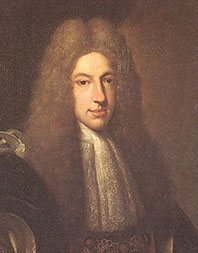
James Francis Edward Stuart (1688-1766), (James III) was born in St. James Palace in London England, in 1688. He married Maria Clementina Sobieski (see below)
Maria Casimira Sobieska - became a nun.
Marie Charlotte Sobieska (1697-1740) married Charles Godefroid de la Tour d'Auvergne, Duc de Bouillon (1706-1771). Charles was the son of Emmanuel Theodose de la Tour, Duc de Bouillon (1668-1730) and Marie Armandu Victoire de la Tremoille (1677-1717)
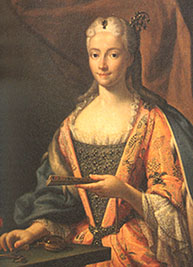
In 1719,Maria Clementina Sobieska (1702-1735) married James Francis Edward Stuart (1688-1766), Prince of Wales, and the Duke of Rothesay (the "Old Pretender"), and was a Chevalier de St. George. Their marriage took place on September 3, 1719 at the Italian Cathedral of Monte Fiascone, in Bologna. Maria Clementina Sobieska was one of Europe's richest heiresses and brought the Stuarts more money. Maria died January 12, 1735, and was buried in St.Peters Cathedral .
However, for all intents and purposes, their marriage ended in 1725, when she left James to enter the Convent of St. Cecilia. Many say Clementia died "insane." The sons grew up warped, with serious psychosexual problems, most likely inherited from their mother. Clementia was prone to depression and anorexia nervosa. She became so thin that her menses stopped. She accused her husband of adultery and his marriage became the joke of Europe. At one point James told her that she was being sinful by leaving her husband and children and she left the convent. However she spent most of her time in prayer and was buried in her nun's habit.
After James VII's death in 1701, Louis XIV, of France, who was on the brink of war with England, promised to help the dead King's son and in March 1708, a sizable French fleet escorted James Edward Stuart to the Scottish coast. However, the English fleet deterred them and they went back to France.
James was exiled in France in St. Germain-en-Laye, near Paris. This was the Chateau where Mary Stuart lived as Queen of France. Maria Clementina discovered James' affair with the Dutchess of Inverness, and on November 1725, she entered the convent at Santa Cecilia. James pleaded for her return, and promised to remove the Duke and Dutchess of Inverness from court. She then returned to the Palazzo Muti, most likely with less trust in her husband. St Germaine-en-Laye was the home in exile of James VII/II until he died in 1701. It was also the home of his son James VIII/III until 1717. Part of the time he also lived in Italy. James Francis Edward was five times proclaimed King of the Scots, and made three attempts to regain his throne. The Tories sought to replace Queen Anne with the rightful heir to the Scottish succession, James. However, James refused to be tied to the Anglican Church, since he and his wife were Catholics. The Italians called him the Deposed King of Britain. This brought on much future controversy.
GENERATION SEVEN
Marie Louise Henriette Jeanne de la Tour
(1)Prince Ferdinand de Rohan Archbishop of Cambrai. He had a mistress named Charlotte of Albany, who was the daughter of Charles Edward Stuart and Clementina Walkinshaw of Borrowfield (his cousin - see children of Maria Clementia).
(2)Prince Louis de Rohan was the Cardinal-Archbishop of Strausbourg and Grand Aumonier of France.
(3)Jules Hercule was the Prince of Rohan, Duc de Montbazon (1726-1788). He married Marie Louise Henriette Jeanne de la Tour, Dutchess de Montbazon (1725-1781). Marie was the mistress of Charles Edward Stuart.
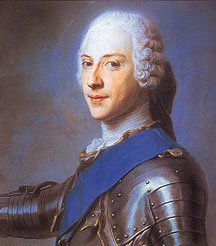
(1)Prince Charles Edward Louis Phillip Casimir Stuart (1720-1788) (Bonnie Prince Charlie), Prince of Wales and Duke of Rothesay. The Vatican also recognized him as the "Count of Albany." Charles was born December 31, 1720 in the Palazzo Muti in Rome. Italy; in a mansion given to his father by the Pope Clement XI. Charles Edward was part of the Jacobite revolution beginning in 1735. Charles was symbolically crowned in September 24, 1745. His army went into England, but had to retreat to Scotland from Derby. They were defeated at Culloden on April 16, 1746. Charles married:
..... (1)Clementina Walkinslaw of Borrowfield, Comtesse d'Alberstaff in 1746. Clementina took their daughter, Charlotte, left Charles and went to the Paris Convent de la Visitation de Sainte Marie in the Rue de Bac. This marriage was annulled in 1766. The Catholic records of Liege in Belgium state that Charles and Clementina were living as man and wife, but had no formal wedding. She is recorded as his "mistress."
..... (2) Princess Louise Maximilienne of Stolberg (1753-1824), the daughter of Gustavas, Prince of Stolberg-Gueden. Charles married Louise, by proxy, in Paris March 28, 1772, then in actuality in Macerata, Italy. In 1784, they were given papal dispensation to divorce since Louise had an affair with Italian poet, Vittorio, Count Alfieri. She left Charles in 1780 to live with Vittoria and they married August 1784. Louise died in 1824 She is the only official wife of Prince Charlie.
Charles was dyslesic and never learned to swim, but accomplished most other things. He spoke fluent French, Spanish, and Italian. He was tall, fair, and handsome, apart from his weak chin. He could handle horses, falcons, and dogs. He was a brilliant marksman. He was good at badminton and tennis. He played the cello well and was said to dance elegantly.
From 1744-1745, Charles was in Paris (incognito) trying to raise French monies to support his invasion of Britain. According to Prince Michael of Albany there was a letter sent by King George II, in 1784, that said Charles could return to Britain from exile, as the Count of Albany. Charles Edward denied this offer. He retired to Florence, Italy, and assumed the title of Charles III of Great Britain, a title he felt he should have had.
In 1784 Charles made a will nominating his brother, Cardinal Henry, de jure Duke of York as his royal heir. However, it was rumored, there was a second will dated January 13, 1788. This will was witnessed by a Dominican Father O'Kelley and Abbe Consalvi (they were also the executors). This will left both Edward (his son) and Charlotte (his daughter) as heirs (Prince Michael of Albany). Charles was said to have suffered from asthma and epilepsy, after a nervous breakdown resulting from his defeat at Culloden. Other accounts say he was an alcoholic from 1770 until his death. However, today it is thought that this was a result of his epilepsy?
[epilepsy is a nervous disorder characterized by convulsions and loss of consciousness].
Charles Stuart was thought to have been a virgin until he met Clementina Walkinshaw.
Prince Charles Edward Stuart died January 31, 1788; at age 67, at the Muti Palazzo in Rome, Italy, of an apoplectic fit, and was buried at Frascati (his brother's cathedral), and was later buried in St. Peters.
[an apopletic fit is the loss of bodily function due to a rupture or blockage of a blood vessel]
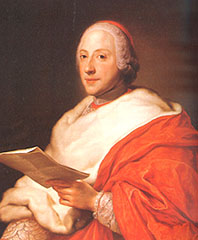
(2)Henry Benedict Maria Clement Thomas Xavier Stuart brother of Charles Edward Stuart, was born March 6, 1725. He was Bishop of Frascati, Duke of York. He became a Roman Catholic cardinal in 1747. He and his brother were not on speaking terms (because Charles briefly became an Anglican), until their father's death in 1766. Henry died in July 1807. In his will he left Edward James, Count Stuarton, as his sole heir. However most accounts day his fortune was gone after the French Revolution. In 1800 George III granted him a pension of 4000 pounds.
GENERATION EIGHT
Prince Louis de Rohan, Cardinal-Archbishop of Stasbourg, Grand Aumonier of France.
Henri Louis de Rohan, Prince de Guémené (1745-1809).
Charles Godefroid de Rohan-Stuartwas born July 28, 1748 and was christened in the Church of St. Paul. He died January 1749.
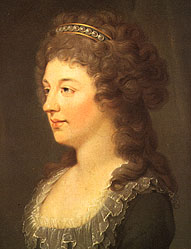
Charlotte de Johnstone Douglas Stuart (1753-1789), used the title of the Dutchess of Albany. Charlotte was born illegitimate on October 1753 in Liege, Belgium. She was baptized in Sainte Maie des Fonts. Charles later made her legitimate. She died in 1789. She was unmarried but had three children by Ferdinand de Rohan Gueneme, Archbishop of Bordeaux. Charlotte was made legitimate and given the Order of the Thistle by her father, Charles. This Stewart line was declared extinct.
Marshall (pg. 200) states: There are no sons to carry on the Stuart line ... so "he [Prince Charlie] instructed his lawyers to draw up a document making Charlotte legitimate." Charlotte had a long-standing affair with Ferdinand de Rohun, the French Cardinal. They had three children and the last was a boy named Charles Edward (de Rohun). Her mother Clementina Walkinshaw was still getting a meager pension in the convent. Charlotte was sick with a liver ailment and died two years after her father of cancer.
SOURCES:
Cheesman, Clive and Jonathan Williams. Rebels, Pretenders, and Imposters. New Yprk: St. Martin's Press, 2000.
Davis, Norman. God's Playground: A History of Poland (Volume I). New York" Columbia University Press, 1982, 489-491.
Gardner, Lawrence. Bloodlines of the Holy Grail. New York: Barnes & Noble Books, 1996.
Gibbon, David. Clans and Families of Scotland: The History of the Scottish Tartan. Edison, N.J.: Chartwell Books, 1999 chart on page 25.
Hook, Michael and Walter Ross. The Forty-Five. Edinburgh: HMSO - The National Library of Scotland, 1995.
Lousa, Jiri and Michael MacKagan. Lines of Succession: Heraldry of the Royal Families of Europe. New York: Barnes & Noble Books, 2002.
Maclean, Fitzroy. Highlanders: A History of the Scottish Clans. New York: Penguin Studio, 1995. Marshall, Rosalind K. Bonnie Prince Charles. Edinburgh: HMSO Publications, 1998.
"The American Branch of the Sobieski Family," (no author given). Polish Genealogical Society Newsletter Volume V, Number 2, Fall 1983, 1, 30, Ross, Stewart. Monarchs of Scotland. UK: Lochar Publishing Ltd., 1990.
Wasilkowska, Anna. Husaria: The Winged Horsemen. Warsaw: Wydawnictwo Interpress, 1998.
Zamoyski, Adam. The Polish Way. New York: Hippocrene Books, 1996.

RELATED LINKS:
John Sobieski (Catholic Encyclopedia) Jan III Sobieski (Encarta) ... The Battle of Vienna

